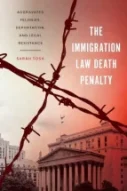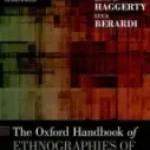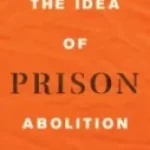The Immigration Law Death Penalty: Aggravated Felonies, Deportation, and Legal Resistance
 Author: Sarah Tosh
Author: Sarah Tosh
Publisher: NYU Press, 2023. 248 pages.
Reviewer: Vernonica Bruey | April 2024
There is an arduous duality of Black and Brown immigrants in the United States of America. First, they are supposed to be super-perfect human beings. Two, they are also unworthy “sub-humans” and “animals.” Any ounce of existence outside this “good-happy-grateful” immigrant conundrum, especially for undocumented migrants from the Global South, will attract the worst of American de-humanity. Classified as “criminal aliens,” they can be penalized (i.e., detained, jailed, and deported) for aggravated felonies (or “immigration law death penalty”), including for misdemeanors such as check fraud and shoplifting.
Considered the most expansive incarceration system and world leader in deportation, the United States went from expelling a maximum of 40,000 non-citizens before 1990 to peaking at 415,587 in 2012 and 432,212 expulsions in 2013 (p3). Named “Deporter-in-Chief,” former President Barack Obama deported over two million people during his tenure (p4)). It is imperative to understand, analyze, and contextualize Sarah Tosh’s important work within past and present perspectives on immigration + crime (crimmigration) at both state and individual levels.
First off, the very thought of describing an immigrant as a “criminal” and an “alien” is a stubborn old age problem. Hours after Japan bombed Pearl Harbour on December 6, 1941, not only were thousands of Japanese immigrants rounded up in internment camps, but racist propaganda also called them “animals” and “subhuman” not worthy of living. (Library of Congress, 2024; Reis et al., 2011; Smart & Weingartner, 2017) Most recently (17 March 2024), during a campaign rally speech in Dayton, Ohio, former President Donald Trump said, “he thinks of some crossing the border as animals or not even people.”(Vera, 2024)
It is this deep racial divide in the alleged commission of criminal acts between citizens and non-citizens that concerns The Immigration Law Death Penalty. Tosh contests that “…punitive and disparate outcomes of the aggravated felony are rooted in inequalities inherent in neoliberal capitalism, exclusionary border enforcement in an increasingly transnational world, and the continued salience of white supremacist racial hierarchies – [a] complex problems not solved through individual policy recommendations” (p170). On a personal level, a personal anecdote is instructive.
As a Black African war survivor and a migrant to several countries in the Global North, the issue of crime and racial violence is ever present, especially when traveling to highly securitized countries such as Canada, the United States, the United Kingdom, and Australia. In mid-February 2024, while in transit at the Vancouver International Airport en route to Australia, I took The Immigration Law Death Penalty to read on the 19hrs plane journey. During this time, we (travelers) were visited by at least 12 Canada Border Services Agency officers. Questions about what I would do in Australia and how much cash I was taking on the trip, could not wait for my arrival in Canberra. Indeed, the Australian border was extended to Vancouver International Airport.
It did not matter that I had previously studied in Australia for years, that I was invited to deliver a keynote address on the Reimagining Migrant and Refugee Justice project, or that I had been teaching/researching migration/refugee law for decades. Evidently, my deepest anxiety lies with the fact that this Black body invokes a kind of hatred and violence that criminalizes me as an “undeserving animal” in this space. In hindsight, the experience imposed an acute sense of awareness that required one to examine the Immigration Law Death Penalty closely. The book comprises five chapters, laid out in 237 pages. The introductory chapter presents a historical and conceptual backdrop that transverses criminalization to the deportation of migrants, citing a unique case example in New York. Interestingly, law enforcement agencies in New York are not permitted to engage in or assist with federal immigration detainers who charge or convict non-citizens of crimes (p16).
While the aforementioned is a constructive effort to see immigrants as humans, a painful lingering reality remains that Black African immigrants in the United States are literally an “endangered species.” Tosh explains:
The Black immigrant population increased fivefold from 1980 to 2016…making up only 7 percent of the non-citizen immigrant population, [but] accounts for more than 20 percent of those who face removal based on criminal convictions. (…). Rather than engaging with the impacts of policing and criminalization on Black immigrants in a racially unequal system of mass incarceration, the mainstream sociology of migration has largely described a cultural distinctness of African and Caribbean migrants that prevents their assimilation into the American Black ‘underclass’ – where immigrant criminality is said to be acculturated. Relying on thinly veiled ‘culture-of-poverty’ theories to explain crime, such arguments uphold anti-black hierarchies and erase structural factors known to shape inequality (p10-11).
To this end, it is not hard to connect the impact of intergenerational trauma as a direct result of the great migration (slavery) on Peoples of African descent, the ensuing racism that continues to invoke violence through a pervasive culture of ignorance and White privilege. That is, the audacity to choose how and when Black/African history should be taught in the classroom. Truth be told, we are all immigrants from Africa, and as humans, we are all predisposed to criminal tendencies!
Dr. Veronica Fynn Bruey is an Assistant Professor, Legal Studies at Athabasca University.


